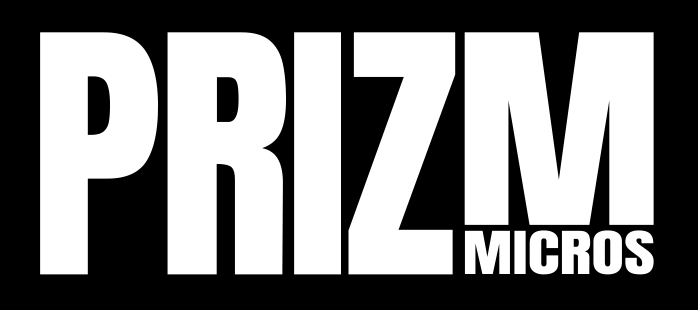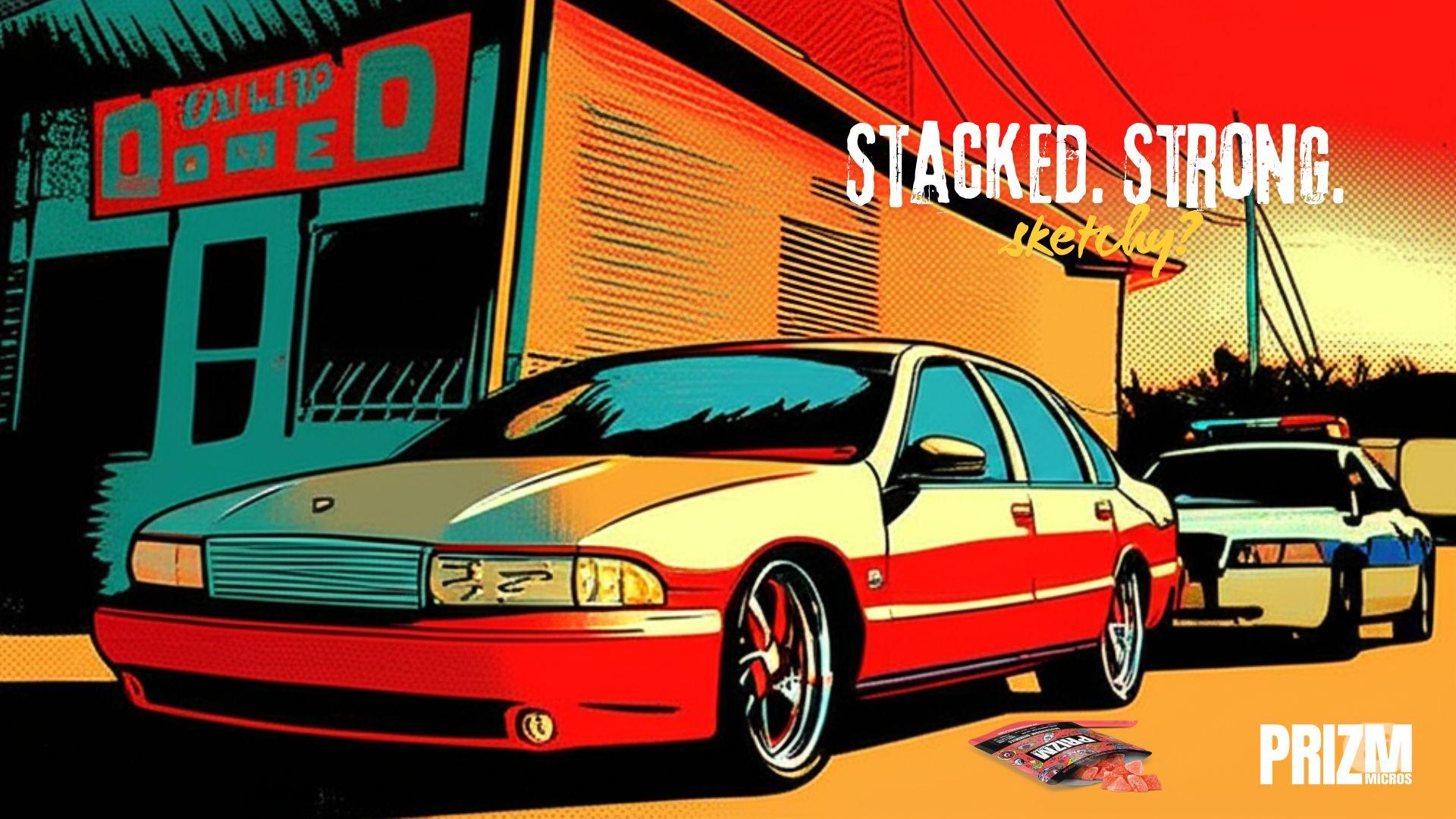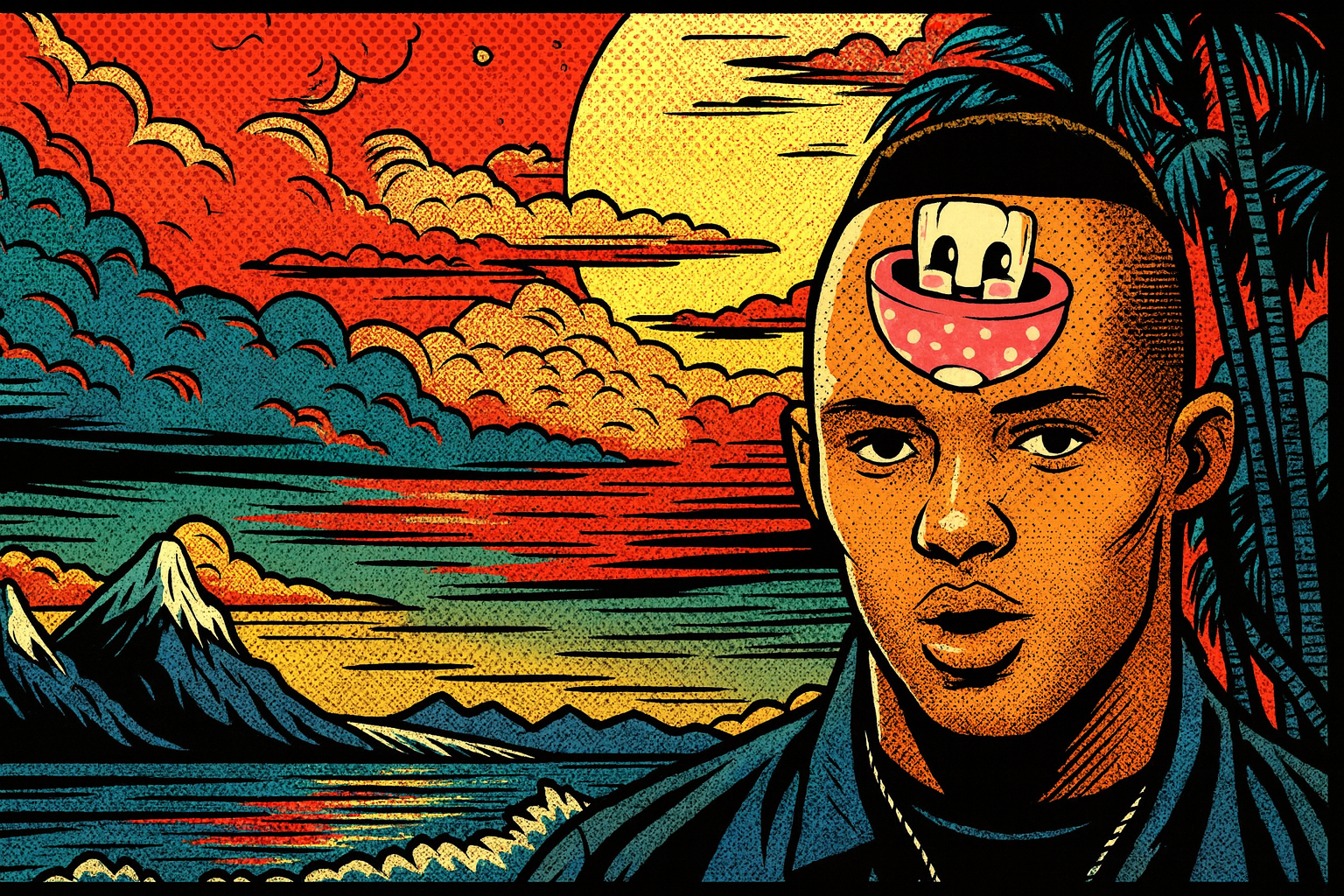You’ve seen them popping up everywhere—from boutique supplement sites to vape shop counters: “Enhanced high potency mushroom gummies.” The name alone sounds like a biohacker’s dream, or a regulatory nightmare.
But what does “enhanced” really mean? Is “high potency” just hype? And most importantly, are these legal?
For anyone riding the wave of functional mushrooms, adaptogens, and mood-supporting gummies, the new crop of supercharged stacks is both intriguing and confusing. These aren’t your average Lion’s Mane chews or sleepy-time Reishi bites. They’re stacked with nootropics, cannabinoids, and sometimes psychoactive compounds. Some promise clarity. Others whisper “elevation.” And more than a few leave users wondering if they just accidentally microtripped at brunch.
This article breaks down the rise of enhanced high potency mushroom gummies—how to decode the labels, spot red flags, and understand what you’re really putting in your body. Whether you’re a curious consumer or a product developer eyeing the market, we’re about to pull back the curtain.
Because clarity starts before the dose.
What Does “Enhanced” Actually Mean?
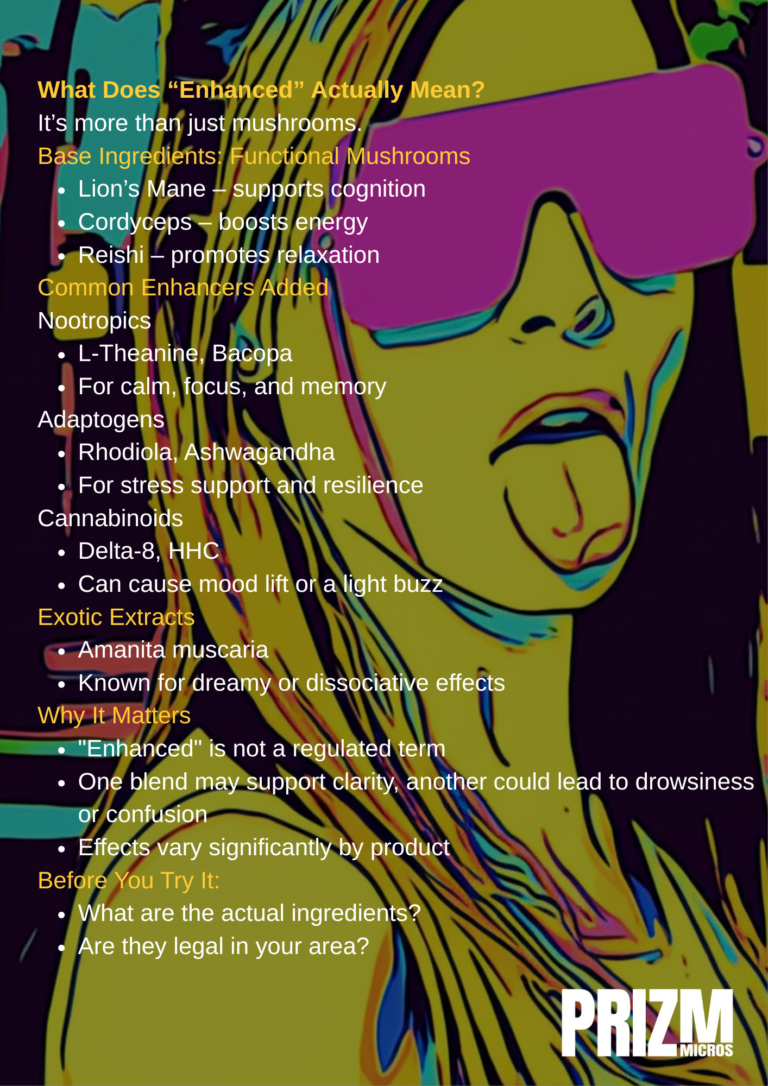
In the world of mushroom supplements, “enhanced” isn’t just clever marketing—it’s a wild west of formulation. The term has no formal definition, which means brands use it to describe everything from added vitamins to borderline psychoactive combos.
At its most basic, enhanced means more than just mushrooms. These gummies typically stack functional mushrooms like Lion’s Mane, Cordyceps, or Reishi with extra actives. Think:
- Nootropics like L-theanine or bacopa for calm, focus, or memory support
- Adaptogens like Rhodiola or ashwagandha for stress resilience
- Cannabinoids like Delta-8 or HHC, which can bring a “buzzed” feeling
- Exotic extracts like Amanita muscaria for dreamy, dissociative effects
Some stacks are designed for flow state. Others aim for mood elevation. A few blur into “microtrip” territory. But here’s the rub: enhanced doesn’t always mean better—it just means different.
And because there’s no consistent standard, one brand’s “deep clarity” could be another’s “unexpected nap.”
So before you dive into an “enhanced” blend, it’s critical to ask: What are the extra ingredients? Are they legal in my state? Do I actually want what this stack delivers?
We’ll get into legality and safety next—but first, let’s unpack what “high potency” really means (and what it doesn’t).
The Truth About “High Potency”: Buzzword or Bioactive?
“High potency” sounds impressive—but without context, it’s basically supplement-speak for “trust us, it’s strong.”
In mushroom gummies, potency should reflect actual bioactive content—like beta-glucans (for immune support), hericenones or erinacines (for cognition), or cordycepin (for energy). But most products skip those details.
Here’s what “high potency” usually means on a label:
- High total milligrams: “2,000 mg mushroom blend” sounds intense—until you realize it’s a mix of fruiting body, mycelium, and maybe rice substrate. Quantity ≠ quality.
- Extract ratios: “10:1 Lion’s Mane” suggests concentration, but unless it’s standardized (e.g., 30% beta-glucans), it’s impossible to verify impact.
- Proprietary blends: This is where it gets murky. Some brands hide low-potency filler behind fancy names like “NeuroStack” or “Mind Matrix.”
So how do you spot real potency?
- Look for standardized actives: e.g., “30% beta-glucans from Reishi fruiting body extract.”
- Prioritize fruiting body extracts, not just mushroom powder or mycelium on grain.
- Check for clear labeling of each active compound, not just a massive blend with zero breakdown.
And if a product doesn’t offer third-party lab testing or a Certificate of Analysis (CoA)? That’s your sign to pass.
When “Enhanced” Gets Complicated: What’s Actually In These Gummies?
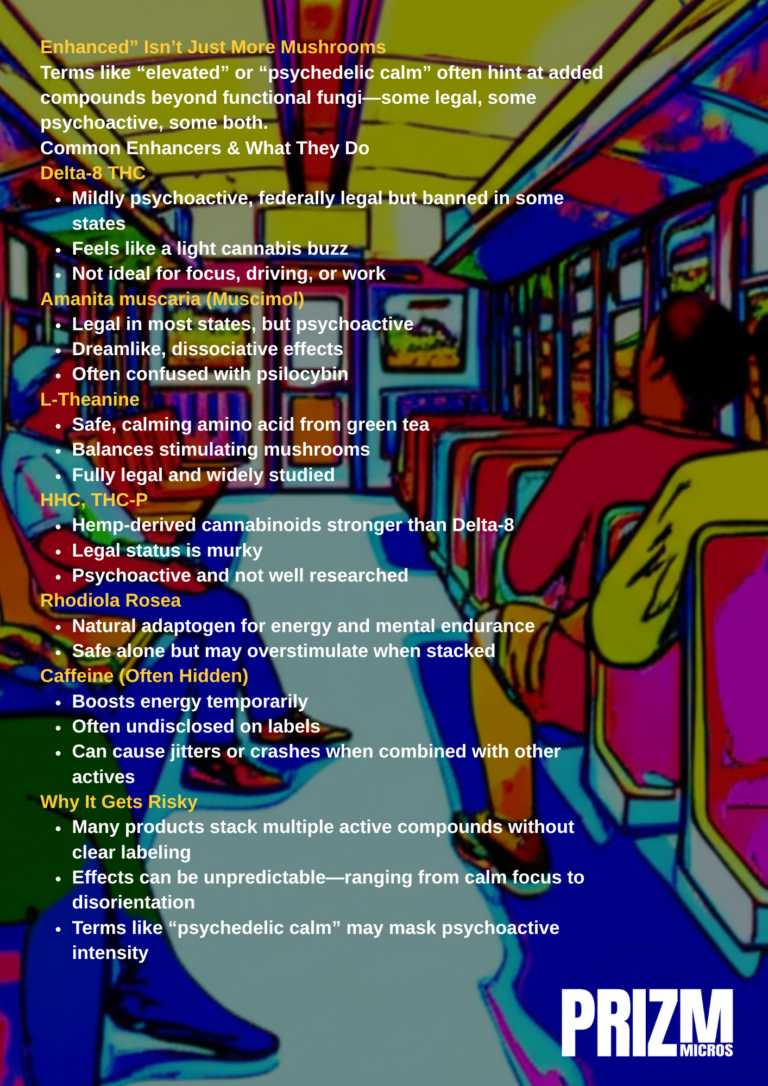
If you’ve seen terms like “elevated,” “psychedelic calm,” or “spiritual support” on a mushroom gummy label, you’re not alone, and you’re not wrong to raise an eyebrow.
“Enhanced” doesn’t just mean extra mushrooms. It often signals the inclusion of non-mushroom compounds, some of which walk the line between nootropic and narcotic. Here’s what’s commonly added:
Common “Enhancers” and What They Actually Do
- Delta-8 THC
Mildly psychoactive, federally legal (for now), but banned in states like New York and Colorado. Known for a weed-lite buzz, not ideal if you’re driving or working. - Amanita muscaria (Muscimol)
Legal in most states but still psychoactive. Often mistaken for psilocybin. Effects can be dreamlike, or just disorienting. - L-Theanine
The chill hero of green tea. Balances stimulating mushrooms like Cordyceps. Safe, legal, and well-understood. - HHC, THC-P
Hemp-derived cannabinoids that feel stronger than Delta-8. Minimal research, murky legality, and definitely not CBD. - Rhodiola Rosea
A natural adaptogen that boosts mental stamina. Safe on its own, but may overstimulate when stacked with mushrooms + cannabinoids. - Caffeine (often hidden)
Boosts energy—until it doesn’t. Look for actual milligrams, not just “natural stimulants.”
The Legal & Safety Line Gets Blurry Fast
When these enhancers are mixed in with functional mushrooms, you’re not just getting wellness—you’re potentially ingesting a stacked pharmacological cocktail. And most brands don’t break it down clearly.
That’s why “enhanced” often leaves consumers confused, overstimulated, or straight-up high, without ever seeing the word “psychoactive” on the label.
Coming up next: the legality maze. Let’s talk loopholes, red flags, and how to stay compliant without sacrificing your vibe.
The Legality Maze: What “High Potency” Really Means (and Where It Crosses the Line)
Let’s get one thing straight: just because a gummy says “enhanced” or “high potency” doesn’t mean it’s illegal. But the line between legal functional gummies and illicit psychoactive edibles? It’s thinner than you think.
What Does “High Potency” Actually Mean?
Brands toss the phrase around like it’s regulated, it’s not.
- Milligram Counts: You’ll see “2,000mg mushroom blend” on labels, but that number often includes unextracted powder, not concentrated actives.
- Extract Ratios: “10:1 Lion’s Mane” sounds fancy, but means nothing unless it’s from the fruiting body and standardized (e.g., 30% beta-glucans).
- Named Actives: Legit products name bioactives, hericenones, cordycepin, beta-glucans, and give you the real deal in real doses.
If a gummy doesn’t say where the mushroom came from (fruiting body vs. mycelium), how it was extracted (dual or hot water?), or how potent it actually is (standardized content?), you’re flying blind.
Where It Can Get Legally Risky
- Delta-8 and HHC
Federally legal via hemp loopholes, but banned in over a dozen states. If you’re traveling with these, you better know your local laws. - Amanita muscaria
Muscimol isn’t scheduled by the DEA, but that doesn’t mean you can sell it freely. Some states have started cracking down, especially if it mimics psilocybin branding. - Unverified Potency Claims
If a product claims “psychedelic calm” but has no lab testing to back it, regulators (and customers) see that as deceptive, and potentially dangerous.
What Keeps a Product Compliant?
- Certificates of Analysis (CoAs): These should be from third-party labs, batch-specific, and easy to access (no email walls).
- Full Ingredient Disclosure: No euphemisms like “Mind Matrix Blend.” We want “500mg Lion’s Mane extract (30% beta-glucans), 20mg Delta-8,” etc.
- GMP/NSF Certifications: A serious trust signal that shows your product was made in a regulated, safe environment.
- Proper Disclaimers: Warnings for people on meds, pregnant users, and advice about psychoactive effects.
Bottom line: “Legal doesn’t mean lame,” but it does mean transparent. Brands that play by the rules and still deliver good vibes? That’s the new gold standard.
How to Decode a Label Like a Pro: Spot the Real from the Rhetoric
If you’ve ever stared at a gummy label and thought, “Wait—what am I taking?” you’re not alone. Enhanced high potency mushroom gummies often look like wellness products… until they don’t. Here’s how to cut through the fluff and know exactly what’s going in your body.
What a Transparent Label Looks Like
A good label should feel more like a blueprint than a mystery novel. Here’s what to look for:
- Exact Mushroom Species & Form: “Lion’s Mane fruiting body extract (500mg, dual-extracted)” > “Lion’s Mane blend.”
- Standardization Details: Percentages matter—beta-glucans (for immune support), hericenones (for cognitive lift), cordycepin (for energy).
- Enhancement Ingredients Listed by Name & Dosage: Not “Elevated Mood Complex,” but “20mg Delta-8, 200mg L-Theanine.”
- Clear Delivery Format: If it includes tinctures (e.g., glycerites or alcohol-based extracts), that should be labeled too, especially for those with dietary restrictions.
What Makes a Potency Claim Trustworthy?
The term “high potency” can mean everything, or nothing. Trustworthy brands do the following:
- Include Third-Party Verified CoAs: Easy-to-access lab reports that break down actives and screen for contaminants (mold, heavy metals, pesticides).
- Break Down Proprietary Blends: “2,000mg Mushroom Complex” tells you nothing. Reputable brands will specify: “1,000mg Lion’s Mane (fruiting body), 500mg Reishi, 500mg Cordyceps.”
- Declare the Psychoactive Load: Especially if there’s Delta-8, muscimol, or THC-P—consumers should know the total experience intensity they’re signing up for.
Red Flags to Avoid
- No Lab Results or QR Code: If you can’t verify what’s in it, don’t put it in your body.
- Overly Vague Terms: “Spiritual support,” “mood journey,” “cosmic calm”—these are smoke signals, not substance.
- Hidden Caffeine or Stimulants: Brands sometimes sneak in caffeine without disclosing the dose, especially in gummies targeting energy.
What Legit Products Share Up Front
- What mushroom part was used (fruiting body = gold standard)
- Extraction method (hot water, alcohol, dual)
- Exact dosage of every active—not just total weight
- Testing standards, certifications, and usage guidance
Enhancement or Overkill? Understanding What’s Really Inside
“Enhanced” sounds promising, until your heart’s racing, your brain’s buzzing, and you’re Googling if Delta-8 and Cordyceps should feel like this. Let’s break down the most common enhancements found in high potency mushroom gummies, what they do, how safe they are, and why they confuse so many buyers.
Common “Enhancers” Explained
- Delta-8 THC
- Why it’s used: Delivers a mild, euphoric high, marketed as legal, chill “weed-lite.”
- Legal status: Federally legal under the hemp loophole but banned in states like NY, CO, and AK.
- Risks: Can cause drowsiness, anxiety, and cognitive impairment, especially in higher doses (10–25mg).
- User confusion: Often mistaken as non-psychoactive due to unclear labels.
- Amanita muscaria (Muscimol)
- Why it’s used: Provides a dreamy, dissociative effect distinct from psilocybin.
- Legal status: Legal in most U.S. states, but not FDA-regulated.
- Risks: Dose-sensitive, with potential for nausea, dizziness, or confusion.
- User confusion: Many consumers think it’s “magic mushroom” psilocybin, which it’s not.
- L-Theanine
- Why it’s used: Promotes calm and focus, counterbalances stimulants like caffeine or Cordyceps.
- Legal status: Fully legal and safe when used properly.
- Risks: Minimal; great for users seeking smoother effects.
- User confusion: Low. One of the most trusted enhancers.
- Cannabinoids (HHC, THC-P)
- Why it’s used: For deeper euphoria and relaxation, often stronger than Delta-8.
- Legal status: Hemp-derived, but more legally volatile.
- Risks: Potency varies wildly. Psychoactive effects may be unexpectedly strong.
- User confusion: Often lumped in with “just CBD,” a dangerous assumption.
- Rhodiola Rosea
- Why it’s used: Adaptogen for energy and mental stamina.
- Legal status: Legal supplement.
- Risks: May overstimulate or clash with SSRIs and anxiety meds.
- User confusion: Viewed as relaxing, but can actually stimulate.
- Caffeine (Synthetic or Natural)
- Why it’s used: Boosts alertness, sometimes paired with Cordyceps or Lion’s Mane.
- Legal status: Legal, common in nootropics.
- Risks: Doses often hidden. Can cause jitters or crash when combined with other actives.
- User confusion: High. Hidden caffeine is a consistent user complaint.
- Bacopa Monnieri
- Why it’s used: Long-term brain support, memory, and clarity.
- Legal status: Legal, evidence-backed.
- Risks: Safe alone, but may interact with other cognitive enhancers.
- User confusion: Often mistaken for Lion’s Mane, needs clearer education.
Why This All Matters
Too many brands lump enhancements into mystical-sounding “proprietary blends.” That’s not innovation, it’s obfuscation. When “enhanced” means unpredictable, users feel blindsided.
Decoding “High Potency”: What the Label Doesn’t Tell You
So a gummy claims “2,500mg high potency mushroom blend.” Sounds impressive, but what does that actually mean? Spoiler: without context, it might mean nothing. Let’s peel back the label and decode what “high potency” really looks like in the wild west of mushroom gummies.
What “High Potency” Claims Usually Mean
- Raw Milligram Count
- Most brands flaunt big numbers like “1,500mg” or “2,000mg” per gummy.
- Problem? It’s often just raw powder—unextracted, unstandardized, and minimally bioavailable.
- Extract Ratios
- Terms like “10:1 Lion’s Mane extract” suggest concentration.
- But without knowing what was extracted (mycelium? fruiting body?) and what actives are preserved (like beta-glucans), it’s just smoke and mirrors.
- Active Compounds
- This is the gold standard.
- True high potency = specific actives clearly listed:
- Beta-glucans for immune support (Reishi, Turkey Tail)
- Hericenones/Erinacines for neurogenesis (Lion’s Mane)
- Cordycepin for stamina (Cordyceps)
- Beta-glucans for immune support (Reishi, Turkey Tail)
- Stacked Enhancements
- Products with Delta-8, caffeine, or muscimol might claim high potency based on total psychoactive effect—not mushroom content.
How to Verify Real Potency
CoAs (Certificates of Analysis)
- Demand a 3rd-party lab report that shows:
- Active compound % (e.g., 30% beta-glucans)
- Purity (free from heavy metals, mold, pesticides)
- Psychoactive content (if present)
- Active compound % (e.g., 30% beta-glucans)
Label Transparency
- Look for language like:
- “500mg dual-extracted Lion’s Mane fruiting body (30% beta-glucans)”
- Not: “1,000mg mushroom blend”
- “500mg dual-extracted Lion’s Mane fruiting body (30% beta-glucans)”
Manufacturer Credibility
- Brands following GMP or NSF standards offer more consistent, safe formulations.
- QR codes linking to lab results = trust points.
Psychoactive Load Disclosure
- If your gummy has Delta-8, muscimol, or caffeine, it should say exactly how much.
Avoiding the Trap: How to Spot Sketchy Gummies Before You Buy

High potency, enhanced, legally grey, this space is booming, but not every gummy is built for good vibes. If you’ve ever picked up a flashy pack with cosmic fonts and vague claims, you already know the risk: weird effects, unclear ingredients, or worse, crossing a legal line without knowing it.
Here’s how to separate the legit stacks from the ones that belong in the trash.
The Smart Buyer’s 8-Step Safety Checklist
- Look for a CoA (Certificate of Analysis)
- No QR code, no trust. Legit brands publish third-party test results for every batch.
- CoAs should verify:
- Active ingredients (e.g., 25mg Delta-8, 500mg Lion’s Mane 10:1 extract)
- Purity: free from heavy metals, molds, solvents
- Active ingredients (e.g., 25mg Delta-8, 500mg Lion’s Mane 10:1 extract)
- No QR code, no trust. Legit brands publish third-party test results for every batch.
- Break Down That “Proprietary Blend”
- “Mushroom Complex – 2,000mg” means nothing.
- Look for individual extracts + percentages:
- Example: “Cordyceps 500mg (dual-extracted, 20% cordycepin)”
- Example: “Cordyceps 500mg (dual-extracted, 20% cordycepin)”
- “Mushroom Complex – 2,000mg” means nothing.
- Check Enhancement Stacks for Interaction Risks
- Delta-8 + Lion’s Mane + Rhodiola? Could be fine, or could spike anxiety.
- If you’re on SSRIs, ADHD meds, or sensitive to stimulants, stack cautiously.
- Delta-8 + Lion’s Mane + Rhodiola? Could be fine, or could spike anxiety.
- Confirm Fruiting Body vs. Mycelium
- Fruiting body = full-spectrum benefits.
- Mycelium on grain = often filler. Bonus if dual-extracted.
- Fruiting body = full-spectrum benefits.
- Match Potency to Your Experience Level
- Just because it’s legal doesn’t mean it’s mild.
- Start low, especially with psychoactives like muscimol or HHC.
- Just because it’s legal doesn’t mean it’s mild.
- Avoid Products with Vague Claims
- “Spiritual calm,” “elevated clarity,” “mind matrix”—if they can’t say what’s in it, you don’t want it.
- “Spiritual calm,” “elevated clarity,” “mind matrix”—if they can’t say what’s in it, you don’t want it.
- Know Your State Laws
- Delta-8 might be federally legal but banned in your zip code.
- Traveling with gummies? Research state-specific regs first.
- Delta-8 might be federally legal but banned in your zip code.
- Check Where It’s Sold
- If it’s only in vape shops or random marketplaces with zero brand traceability—hard pass.
- If it’s only in vape shops or random marketplaces with zero brand traceability—hard pass.
5 Red Flags That Should Stop You Cold
- ❌ No lab results available pre-purchase
- ❌ Uses only euphemisms like “bliss blend” or “trippy calm”
- ❌ No mention of enhancement dosages
- ❌ Priced way below market average ($10 for 10 “high potency” gummies? Run.)
- ❌ Sold next to THC edibles with no clear differentiation
Final Thoughts: Potency, Legality, and Why Transparency Matters
In a world where “enhanced” can mean anything from a focus boost to a full-on sensory shift, clarity isn’t a luxury, it’s a lifeline. Whether you’re stacking for peak performance, creative flow, or just want a legal mood lift, knowing what’s in your gummy matters. Not just for your safety, but for your peace of mind.
The truth? High potency doesn’t have to mean high risk. But too many brands blur the lines between functional support and psychoactive play, between science-backed and marketing fluff. That’s where trust breaks, and where we step in.
At PRIZM Micros, we do things differently. Every gummy is built for clarity, calm, and consistent feel-good vibes, no surprises, no sketchy ingredients. We combine legal tryptamines with high-quality functional mushroom extracts (always fruiting body), and we back it all up with third-party testing, clean sourcing, and transparent labels. Because “legal” shouldn’t feel like a gamble.
Whether you’re looking to elevate your day, wind down your night, or unlock that sweet spot of mental clarity, we’ve got a blend that fits your vibe, and fits the law.
Snackable psychedelics. Built for vibes. Backed by science.
Disclaimer:
This content is for educational and informational purposes only. PRIZM Micros products are dietary supplements that do not contain psilocybin, THC, or any controlled substances. All ingredients used comply with applicable federal and state laws. We do not make medical claims or promote psychoactive effects. Please consult a healthcare provider before using any new supplement, especially if you are pregnant, nursing, taking medication, or have a medical condition. Product availability and legality may vary by jurisdiction.
